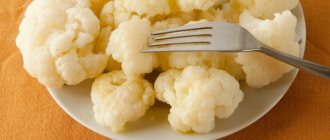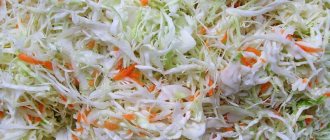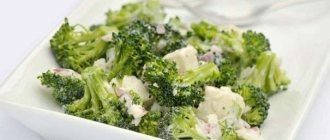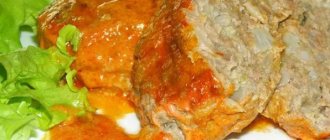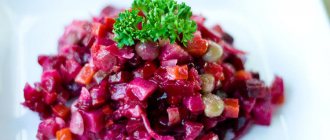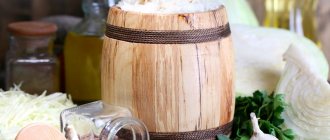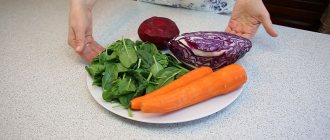Basic principles
To obtain delicious pickles, it is recommended to adhere to certain rules:
- Middle and late varieties of cabbage are best suited for pickling;
- choose dense heads of cabbage without any damage;
- salting is done in wooden, glass or enamel containers;
- You can prepare vegetables in a separate container, and then transfer them to jars for permanent storage;
- coarse salt is used to process vegetables;
- Pickling time ranges from several hours to 3 days, which is determined by the recipe.
Additional tips for sauerkraut
To make the product tasty and juicy, you need to pay attention to some nuances when preparing:
- moon calendar. When fermenting, it is recommended to pay attention to the lunar phases. It is best to make preparations for the new moon;
- lack of vinegar. It is best for the vegetable to ferment naturally. When adding vinegar, the beneficial properties of the vegetable are significantly lost. An exception can be made only if the vinegar is homemade;
- oppression. When fermenting in a barrel, a load is required, and when preparing in a three-liter jar, you will need a simple plastic bag. Fill half the bag with water, release the air and tie a knot at the very end of the bag. After which the bag is carefully pushed into the neck of the jar, where it presses down the cabbage;
- suitable additives. You can add carrots, apples, lingonberries or cranberries to the preparation. For lovers of spicy foods, ginger and garlic are suitable. Onions are not recommended as an additive; in this case, the fermented vegetable cannot be stored for a long time;
- adding spices. You can diversify the taste of your preparations by adding cumin, coriander or anise seeds to the jar;
- fermentation. After salting and placing oppression in a jar for 2-3 days, you need to ensure the temperature for the jars in the room is 18.. 20°C. After this period, the jars should be moved to a place where the temperature is 0°C. Foam that will regularly appear in the jar must be removed regularly. The fermentation procedure can be considered complete if foam does not form on the surface and the brine has become transparent.
Material on the topic Juniper - types, cultivation and care, medicinal properties
If there is no juice in the cabbage during pickling, it is important to understand why this happens and how best to solve this difficulty. Following these tips, you can successfully cook it and avoid the lack of juice in the vegetable.
Delicious pickling recipes
Salting cabbage in pieces takes place in several stages. First, cabbage is chopped, carrots, beets and other vegetables are chopped according to the recipe. The prepared ingredients are poured with a marinade containing salt, sugar and spices.
Simple recipe
The easiest way to salt cabbage is to use carrots and brine. The cooking procedure consists of certain stages:
- A head of cabbage (2 kg) is cut into several parts, which are placed in a jar.
- Between the pieces make layers of grated carrots.
- The garlic head is peeled, then chopped and added to the rest of the vegetables in the jar.
- The pickling marinade is prepared by dissolving 50 g of salt and 160 g of sugar in one liter of water. After boiling, add 0.1 liters of vinegar and sunflower oil to it.
- Sliced vegetables are poured with marinade and left for 3 days until ready.
Quick recipe
You can get a ready-made dietary supplement in a few hours using vinegar. It is most convenient to do all the preparations in the evening, then the vegetables will have time to marinate until the morning.
A recipe for quick pickles consists of a number of steps:
- One head of cabbage is cut into strip-shaped pieces.
- Peel and chop the carrots.
- Three garlic cloves finely chopped.
- Place a pan containing 0.3 liters of water on the stove. For the brine, you need to add sugar (40 g), salt (80 g), black pepper (3 pcs.) and vinegar (40 ml).
- Vegetables are placed in a common container; they should be crushed a little by hand to form juice.
- The vegetable mixture is poured with hot marinade, then covered with a plate on top. Any heavy object is placed on top.
- After two hours, the load is removed and the vegetables are mixed.
- The total preparation time for pickles is 8 hours.
Spicy pickling
Garlic and hot pepper will help add spiciness to the dish. Instant spicy pickles are prepared according to the following recipe:
- A head of cabbage (2 kg) is cut into several large pieces.
- Two carrots must be cut into circles.
- Three cloves of garlic are put under pressure.
- Hot capsicums are freed from seeds and finely chopped.
- Vegetables are placed in a container for pickling, with several bay leaves placed between them.
- One liter of water requires 100 g of sugar, 60 g of salt and a couple of tablespoons of vinegar.
- Pour the marinade into the sliced vegetables while it has not yet cooled down.
- Keep the vegetables at room temperature for two hours, then put them in the refrigerator.
- In a day, the appetizer will be finally ready.
- Salted cabbage is used as a side dish or salad.
Recipe with beets
When beets are added, the pickles acquire a sweetish taste and a bright red color.
You can pickle cabbage using this method by performing certain operations:
- First, take a head of cabbage weighing 2 kg. It must be coarsely cut into squares with sides of 4 cm.
- The beets are grated.
- The cloves from one garlic head are placed under a press.
- The cabbage must be thoroughly mashed with your hands, then placed in a container with the addition of garlic and beets.
- You can get brine by boiling 1 liter of water, into which 50 g of salt and sugar are placed. For seasoning, use 2 bay leaves, one clove and 4 pieces of black pepper.
- The marinade is poured into the container with the slices, and any heavy object is placed on top.
- The vegetables are mixed every day. It will take 3 days to fully prepare the snack.
Recipe with beets and horseradish
Another pickling option is to use not only beets, but also horseradish. This combination allows you to prepare a spicy addition to main dishes.
The recipe for the snack is divided into a number of stages:
- A large head of cabbage weighing 3.5 kg is cut into large pieces.
- Then take beets weighing 0.5 kg. It needs to be cleaned and then cut into small pieces.
- Place a container with 2 liters of water on the stove, dissolve ½ cup of sugar and salt in it. Be sure to add 5 bay leaves, 4 cloves, 7 allspice peas.
- After adding the spices, the brine should cool to room temperature.
- Pass 4 garlic cloves through a press.
- Two horseradish roots are passed through a meat grinder. A plastic bag should be attached to it, into which the crushed ingredient will fall. This way you can avoid eye irritation that horseradish causes.
- All vegetables are mixed in one container, then a heavy object is placed on top.
- The container is left in a cold place for 2 days, after which the vegetables can be served.
- Pickled vegetables should be placed in the refrigerator for the winter.
Recipe with beets and carrots
During the pickling process, you can add carrots and beets to the cabbage. This is another quick cooking recipe that includes a certain sequence of actions:
- Late ripening cabbage (2 kg) is cut into large pieces.
- Two carrots need to be chopped into circles.
- The beets must be cut into cubes.
- Vegetables are placed in a glass jar in several layers. The container must first be sterilized.
- Pour one and a half liters of water into a separate pan, measure out 2 tbsp. l. salt, ½ tbsp. l. sugar, 1 tsp. vinegar and sunflower oil.
- The brine needs to be boiled, then filled with it in a container with vegetables.
- With this recipe, the salting process takes a day. For further storage, choose any cool place.
Salting with spices
When spices are added, the appetizer becomes especially aromatic. In this way, you can salt not only the cabbage itself, but also combine it with carrots and beets.
The recipe for delicious preparations consists of a number of steps:
- A two-kilogram head of cabbage is cut into several parts.
- Grate two carrots and one beet on a coarse grater.
- Two garlic heads need to be peeled and then placed under a press.
- All ingredients are mixed and placed in an enamel bowl.
- Per liter of water you need: 0.1 kg of salt, 150 g of sugar and 150 ml of sunflower oil. The seasonings used here are bay leaves and allspice, 2 pieces of each.
- The brine is boiled, then the pan is removed from the heat and the liquid is poured over the vegetables.
- You need to place a plate and a heavy object on top of the vegetable slices.
- Pickled vegetables will be ready after a day.
Calculation of the required quantity for sauerkraut
The fermentation process is lactic acid fermentation, which requires vegetables with sufficient sugar content. Late varieties of cabbage at the stage of full ripeness have this characteristic. In addition to spices, chopped carrots are usually added to the preparation. Vegetables should be thoroughly ground and placed tightly in a clean container to stimulate the appearance of juice and the development of lactic acid bacteria.
Salts
The amount of salt required for fermenting cabbage of traditional taste is indicated for already chopped cabbage and its consumption is:
- 25 g or 1 tbsp. l. (without slide) per 1 kg of vegetable;
- accordingly, for 2 kg of cabbage you need 50 g or 2 tbsp. l.;
- for 5 kg - 125 g or 5 tbsp. l.
Important! Salt used for canning should not be iodized! You can take both coarse and fine grinding.
Carrots
Carrots are a classic addition to fermented products; they improve taste and appearance, but are not necessary and their quantity is not strictly regulated. It is believed that the mass of additives should not exceed a tenth of the main vegetable, therefore the proportion is as follows:
- For 1 kg take 100 g of carrots;
- for 2 kg - 200 g;
- for 5 kg - 500 g.
In addition to carrots, beets and spices (cumin, coriander, black pepper) are often added to preparations; you can add lingonberries, cranberries, and apples.
Material on the topic Watering garlic in detail from A to Z: the most important rules, manual, drip method, sprinkling, the most common mistakes
Cabbage pieces "pelyustka" for the winter in a jar
Let's start with the most popular cooking option. We will prepare pickled cabbage without vinegar. To give it a soft pink hue, add a small amount of beets. And in order to preserve such a preparation until spring, we compact it into a 3-liter jar.
- Fresh cabbage - 2-2.5 kg.
- Salt - 1 tbsp
- Granulated sugar - 2 tablespoons
- Water - 1 liter
- Beetroot - 1 pc.
1. First of all, let's prepare the marinade. Pour cold boiled water into a liter jar. Add salt and granulated sugar to it. The amount of bulk ingredients is indicated in the layout. Mix everything until completely dissolved
2. Now we take a head of cabbage in our hands. Be sure to inspect it externally; if there are rotten places, cut them off. It is advisable to remove the top sheets. Cut the forks into two equal parts. Cut out the stalk.
We will cut the cabbage into pieces. The average size of one square is 4 cm. Don’t make it too small, it’s better to leave the piece a little larger.
3. To give our preparation soft pink flowers, we will use beets. We peel the red vegetable in advance. Cut into plates 3-4 mm thick.
Now let's start laying out all the cut ingredients. Take a clean, sterilized jar. We put part of the cabbage in it, then put the beets in one layer. So we fill the whole jar.
Do not compact the cabbage or crush it while laying it down. This way it will retain all its juice and release it only during marinating.
Pour pre-prepared marinade over all vegetables. Place the jar in a deep plate or any other dish. Leave to marinate for 3 days at room temperature. Then we put it in a cooler room for another 4 days.
The first three days the cabbage will ferment. That is why excess air should be released from it using the piercing method.
After the time has passed, take out the pickled vegetable and try it. I assure you it turns out very tasty and crispy. If you decide to prepare cabbage according to this recipe for the winter. Then cover it with a nylon lid and put it in the refrigerator.
Step-by-step recipe for crispy sauerkraut with brine for a 3-liter jar
You can also prepare it this way. By the way, if you like to add a lot of different spices to your preparations, then you can add your favorite ones to the brine.
Read also: Ferret in nature photo
Ingredients:
- Cabbage - 2.3-2.5 kg
- Carrots (medium) - 1 pc.
- Salt - 2 tablespoons
- Sugar - 1 tablespoon
- Black peppercorns – 15 pcs.
- Water - 1 liter
Preparation:
1. Shred the cabbage in any way you like. Grate the carrots on a coarse grater. Place everything in a large bowl or basin. Mix thoroughly, pressing lightly with your hands until the juice comes out.
2. Next, put everything in a jar, sprinkling with peppercorns. Press lightly with your hand, slightly compacting it. Leave some space at the top.
3. Now let's make the brine. Add salt and sugar to the water. stir properly until they dissolve.
4. Now fill the brine to the top. Place the jar in a bowl and cover with a lid. Leave at room temperature for a day.
5. The next day you will see that the cabbage has given juice. Pierce it in several places with a long wooden stick to the very bottom so that gases come out. This needs to be done several times a day. The brine will flow into the bowl in which the jar is standing. Add it back to the jar. Continue to do this throughout the entire fermentation time. In total they should stand for three days.
6. On the third day, our white cabbage will be completely fermented and ready. Close it with a lid and store it in a cool place.
Lids can be used either nylon or rolled up with metal ones.
A delicious recipe for Korean cabbage in brine
The name itself speaks for itself. In Korean, it means it contains one of the ingredients that will give it a spicy taste. The advantage of this marinating is that you can use a set of seasonings that you like. Giving the cabbage an even more spicy and excellent taste.
- Cabbage - 1 head
- Carrots -2 pcs.
- Hot pepper - 1 pod
- Garlic - 3 cloves
- Sunflower oil - 100 ml.
- Salt - 1 tbsp
- Sugar - 3 tbsp
- Water - 1.5 liters
1. Clean the head of cabbage from dirt. Cut into two equal parts, remove the stalk. Cut into slices. Then we divide each part into squares. On average, the size of one is 3.4 cm.
2. Peel the carrots. Cut into plates, then cut each into strips. Preferably thinner. You can grate it, but then keep in mind that the vegetable will turn out mushy. Which doesn't quite suit us.
3. Peel the garlic and pass it through a press. Cut the capsicum into small slices. Without removing the seed.
Mix all prepared ingredients in one bowl. Let's put them aside for a while. And let's start preparing the brine. Pour the required amount of water into the pan. Add salt and sugar, bring the mixture to a boil. At the end of the boil, add vegetable oil.
Pour the prepared marinade over all the vegetables. Please note that the vegetables must be completely covered with brine. Leave the cabbage at room temperature until completely cooled.
As soon as the pickled cabbage has cooled, divide it into jars of different sizes. It’s more convenient for me to store it in a container no larger than half a liter. It is preferable to serve this preparation with boiled potatoes. And for any holiday table.
The main reasons why there is little brine in sauerkraut
The most common reasons why cabbage is dry are the wrong variety of vegetable, as well as violations of the pickling technique. Let's tell you more about them.
Choosing the wrong variety of cabbage
When choosing a vegetable for pickling, you need to pay attention to its variety. For this purpose, you need to take only mid-late and late ripening varieties of white cabbage. The need to use only these varieties is due to the fact that the vegetable ferments when lactic acid forms in it.
Important! Ready sauerkraut should not be frozen, otherwise it will lose a large number of its beneficial properties. The optimal temperature for its storage is 0.. 2°C.
And for lactic acid to appear, you need natural sugar in sufficient quantities, and it appears in the vegetable in late autumn. Vegetables that ripen early are not suitable for pickling because they contain little sugar, which will negatively affect the fermentation processes.
Violations of pickling technique
There may be little juice in the preparation if you add little salt to it during the cooking process. Salt promotes the release of liquid; its optimal amount can be considered 25 g per 1 kg of product. You can determine whether everything is in order with the product within a day. This is enough for the juice to appear on the surface of the workpiece, and the whole of it should be immersed in the juice.
Material on the topic Schedule of magnetic storms for April 2020: the most powerful storms and ways to protect yourself
Crispy cabbage marinated in instant pieces
I bring to your attention another recipe. We'll look at it step by step in the video. I promise you will get amazing crispy cabbage as a result. It is quite easy and simple to prepare. The most important advantage is that we will cook according to grandmother’s recipes. This means that this version of pickled vegetable has been in great demand for many years.
I would like to thank the author for such an informative cooking lesson. Did you remember to save it to your piggy bank? I'm so glad I came across such an awesome crispy vegetable recipe.
Marinate cabbage and beets in a 3-liter jar
Beets will give our white cabbage a bright pink color. And it will saturate it with its vitamin taste and aroma. Simply put, adding a red vegetable to a pickled snack will only add positive qualities. Ready for extreme, I’m talking about those who are encountering such a combination for the first time.
- Fresh cabbage - 1 head medium
- Carrots - 2 pcs.
- Beets - 2 pcs.
- Horseradish - 1 root
- Water - 1.5 liters
- Salt, sugar - 70 g each.
- Garlic – 5 cloves
- Vinegar essence - 1 teaspoon
1. First of all, let's prepare the vegetables. Peel the carrots and beets. Then cut the carrots into circles and the beets into slices. Place on the bottom of a sterilized 3-liter jar.
Peel the garlic. Divide into three parts and add to the rest of the vegetables. Cut the horseradish into small pieces.
2. Remove the top leaves of white cabbage. Remove the stalk and cut into cubes. The average size of which should be 3 by 3 cm. This does not mean that you need to run around with a ruler. Just try not to get too small.
Place all the cabbage in jars. Lightly tamping, but not using force.
Now that the vegetables are all prepared, and the jar is filled to the very brim. You can start preparing the brine. For this we need a large saucepan. Pour one and a half liters of water into it, add salt and sugar. Bring to a boil, simmer for 1-2 minutes.
While the brine is preparing, pour a teaspoon of essence into each jar. Pour the prepared marinade on top. Leave the jars to sit for 5 minutes, then seal tightly with sterilized lids.
Turn the finished pickles upside down. Place on a flat surface and cover with a warm blanket. Leave in this state until completely cooled. Then we put it away for storage in the pantry or cellar.
From this amount of products we got two 3-liter jars of pickled cabbage.
Cabbage for the winter under iron covers
The easiest quick recipe. Despite the speed of preparation, the white vegetable turns out crispy and very tasty. The main thing is to follow all the recommendations and you will definitely succeed. With such a minimal amount of ingredients, we get an amazing snack for every day.
- Cabbage - 1-2 heads
- Vinegar 70% - 1.5 teaspoons per 3-liter jar
- Water - 1 liter
- Sugar - 1/2 cup
- Salt - 1.5 tbsp
To add spiciness, you can use black peppercorns. For more flavor, add a couple of allspice peas.
1. Wash the white cabbage. We clean the top leaves and remove the stalk. If rot forms, be sure to cut it off. The vegetable will be cut quite coarsely, the size of the pieces will be arbitrary. It is important that the shredded cabbage fits through the hole in the jar.
Immediately put each piece into a jar. Lightly pressing together.
The jars are filled, you can start preparing the marinade.
Please note that to preserve pickled cabbage, jars and lids must be sterilized. Absolutely any method of sterilization can be used, both over steam and in the oven.
2. Pour the required amount of water into the pan. In our case it is 8 liters. And according to the scheme above indicated in the recipe, we calculate the amount of salt and sugar.
Bring water to a boil, add bulk ingredients. Bring to a boil again and fill the prepared cabbage jars with brine.
Fill the jars with brine to the very brim. Now add vinegar to each jar. And roll up tightly with sterilized lids.
Turn the pickled cabbage over with the lids down. And leave it in this state until it cools completely.
This preparation should be stored in the same way as other pickles. In a dark, preferably cool place.
Sauerkraut – preparing vegetables
Cabbage is selected from late varieties - they have more sugars and the fermentation process is more active. It is not difficult to recognize late cabbage - the heads of cabbage are small, heavy and very dense. Early and middle cabbage has loose heads of cabbage and green leaves.
If you decide to ferment cabbage with carrots, then the proportions are as follows – for 10 kg. cabbage take 300 grams. carrots. But these are just recommendations, and whether to follow them or not is a matter of taste.
For pickling salt, use only coarse table salt. Neither small cabbage nor iodized cabbage is used - the cabbage will turn out soft and have an unpleasant aftertaste. The amount of salt is 200 – 250 grams per 10 kg. cabbage But again, this is a matter of taste.
Cabbage is fermented not only with carrots; beets, apples, lingonberries, cranberries, bay leaves, caraway seeds, and spices can be added. Additives are added to taste.
Step-by-step recipe for cabbage pieces under pressure
And finally, I suggest considering another option for pickling cabbage. We will initially cook it in a saucepan. Withstanding several days under oppression. And after the required time, we will transfer the finished product into jars. Well, let's start learning another quick cooking recipe.
- Cabbage - 1 head
- Garlic - 1 head
- Beets - 1-2 pcs.
- Red capsicum – 1 pc.
- Salt - to taste
- Black peppercorns - 5-6 pcs.
1. Cut the cabbage into large pieces along with the stalk. Naturally, having first removed the first leaves.
Peel the beets and cut them into thin slices 3-4 mm thick. Peel the garlic and divide it into several cloves. Chop the hot pepper arbitrarily, but not too coarsely. In this case, we do not remove the seeds.
2. Place all our vegetables in a fairly deep pan. We will lay them in layers, alternating each one. We start with a chopped head of cabbage. Then beets, red pepper and garlic.
Do not fill the pan to the very top. It is necessary to leave at least 5 centimeters.
3. Preparing the marinade. Take another pan and pour water into it. Add salt to taste; the water should be slightly salted, unlike regular dishes. Bring the liquid to a boil and add the peppercorns. Boil for another 2 minutes.
Then carefully pour the prepared brine into the pan with the vegetables.
Again, without adding the marinade to the very top. Since during installation of the oppression everything will begin to pour out over the edges. It’s better to add it later if there is not enough liquid.
Place pressure on top of the cabbage. First, place a plate of suitable diameter. We place a small weight on top of it.
We remove the pan with pressure in a cool place for 4-5 days. After the time has passed, we take it out and taste it. If you wish, you can put the finished product into jars and store it in the refrigerator.
How many delicious recipes we have reviewed today. Now it's a matter of choice. If you were delighted with everyone, just save the article to your bookmarks. Or share it on your social networks with your family, friends and just people you know.
This is where I end, I want to wish you more sunny days in your life. And of course, delicious preparations until spring! Bye friends...
The popular snack has more than one recipe. Cabbage is salted both shredded and literally in heads. Sometimes they are sorted into separate sheets, but the appetizing pieces look even more beautiful on the table. Today we are learning how to salt cabbage for future use and immediately to the table, in large and small batches.
Pickling cabbage in large pieces
“It’s selling like hot cakes,” we can safely say about the spicy cabbage cooked in the style of Korean cuisine. That’s right, the demand for such treats is very high. They are good for hot dishes on their own; they are taken with you to a picnic for barbecue, but they are also very popular at home parties.
Today we are talking about how to salt cabbage in pieces or layers. Make the treat spicy or mild, color it with beets, or prepare a snack in a natural color. We will describe the preparation of small portions a little later, but for now we will practice how to salt cabbage in large pieces in larger volumes.
The composition of the brine does not change significantly, only quick salting methods are used less frequently. The container for salting is selected, first of all, based on the volume of the workpiece, although the general requirements for it remain unchanged.
The best containers for pickling cabbage are glass, wood, or, in extreme cases, enameled. Plastic dishes are also suitable, it is only important that the material is suitable for storing food. It is unacceptable to pickle cabbage pieces only in aluminum containers without special coatings.
The remaining requirements for containers are reduced to standard hygiene for food preparations. It should be washed clean and not emit any odors from previous preparations. It is highly advisable to steam the containers or at least scald them with boiling water before pickling the cabbage in pieces.
Quick pickling of cabbage pieces
This is a fairly simple and quick way to pickle pieces of cabbage.
Let's take the following ingredients:
- Cabbage - 1 kg.
- Carrots - 1 pc.
- Garlic - 4 cloves
- Sugar – 4 tbsp. l.
- Salt - 2 tbsp. l.
- Vinegar - 1 glass
- Vegetable oil - 1 cup
Wash the cabbage and cut into large pieces. Grate the carrots or cut them into rings. Finely chop the garlic or squeeze it through a press.
We put everything in a jar in layers: a layer of cabbage, a layer of carrots with garlic. After this, pour in hot marinade: dissolve salt, sugar, vinegar and vegetable oil in water. Pour in the vinegar after removing the marinade from the heat.
We pour it all into a jar and leave it for a day. After this you can eat it.
And in this video you can see how to quickly pickle cabbage.
Pickling cabbage allows you to get a delicious appetizer for the main dish in a short time. It is very convenient to cut the cabbage into several parts without further chopping. There are various options for how to salt cabbage in pieces. They do not require a lot of time to prepare the components and the salting itself.
How to pickle cabbage in layers
The next practical example is closer to where we started the story, namely sharp preparations. Our treat will turn out beautiful and appetizing, you just have to comply with all the conditions. Salting cabbage in large pieces in a cold way with hot spices is popular in the cuisines of different nations; let’s take a recipe from Caucasian cuisine, and we will lay it in layers, alternating with grated vegetables.
Ingredients:
- white cabbage – 5 kilograms;
- one medium-sized beet;
- head of garlic;
- a large bunch of juicy cilantro;
- a pair of celery and parsley roots;
- three large hot peppers, red.
In the brine we use:
- 5 liters of clean water;
- cinnamon stick;
- two dozen peppercorns;
- 5 bay leaves;
- a quarter kilo of salt.
Before pickling the cabbage in large pieces, prepare the brine. In water heated to a boil, stir, completely dissolving, coarse salt. We omit the spices and boil for about five minutes, then cool the mixture completely and strain it with layers of gauze.
We disassemble the cabbage from the outer leaves and place them on the bottom of the container selected for pickling. Chop the heads of cabbage coarsely, removing the stalk. Chop the greens, peppers with seeds, garlic and vegetables thinly. Place cabbage in a tub or bucket, layer with vegetables and herbs.
As in the previous recipe, before pickling the cabbage in pieces, cover it with whole leaves, pour in cold brine and press with pressure. After a week, the spicy cabbage will be ready; you can store it either in the same container in which you salted it or by transferring it to jars.
Cabbage in layers in glass jars for the winter
The salting method from the previous recipe is easy to adapt if you like salting cabbage in layers, but want to make an appetizer with a longer shelf life. We reduce the amount of products proportionally, exclude hot pepper, remove cinnamon. No other changes to the ingredients are required.
We fill the jars with pieces of cabbage, just as we put it in a pickling container. Pour in the marinade, strained but still hot. Immediately place the jars in a pan with warm water and turn on the heat underneath. Salting cabbage pieces in jars for the winter requires sterilization. We keep the jars in boiling water for about 20 minutes, then we seal them and roll them up, keep them under warm clothes until they cool down, upside down.
How to salt spicy cabbage pieces with horseradish
The classic pickling of cabbage in pieces for the winter in jars also allows for spicy recipes, and it is not at all necessary to put hot peppercorns in the pickle. Prepare some cabbage with horseradish; the treat perfectly complements both hearty dishes and acts as a salad. It is permissible to grate the cabbage, but it is better to serve it in slices that are aromatic and a little crunchy.
Ingredients:
- one kilogram of cabbage;
- 150 grams of peeled horseradish;
- a spoonful of vinegar essence;
- 100 grams of carrots.
